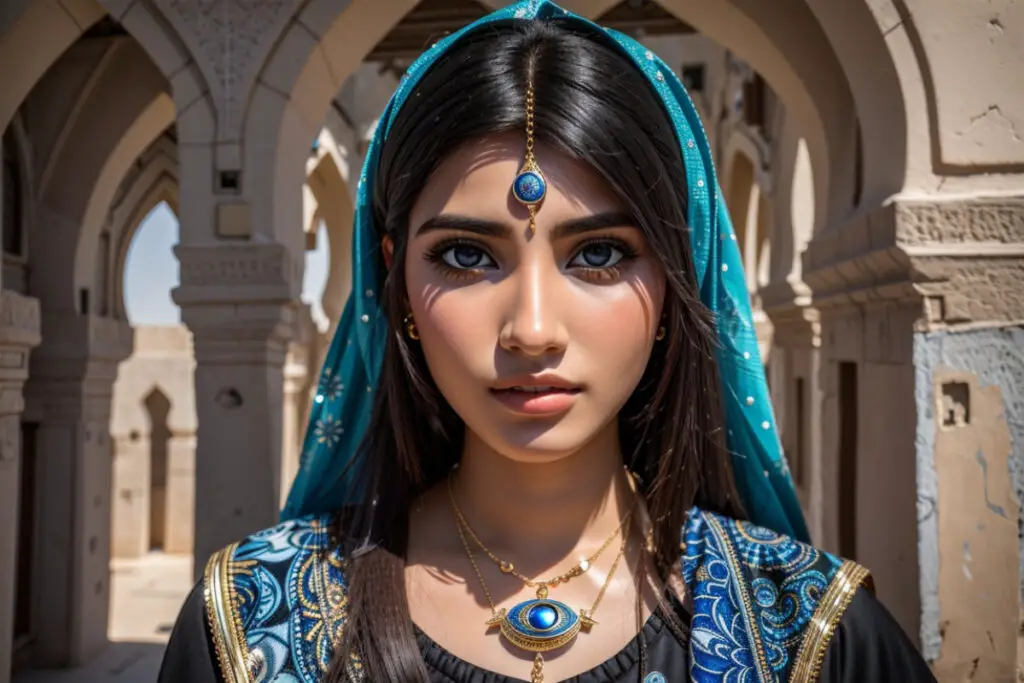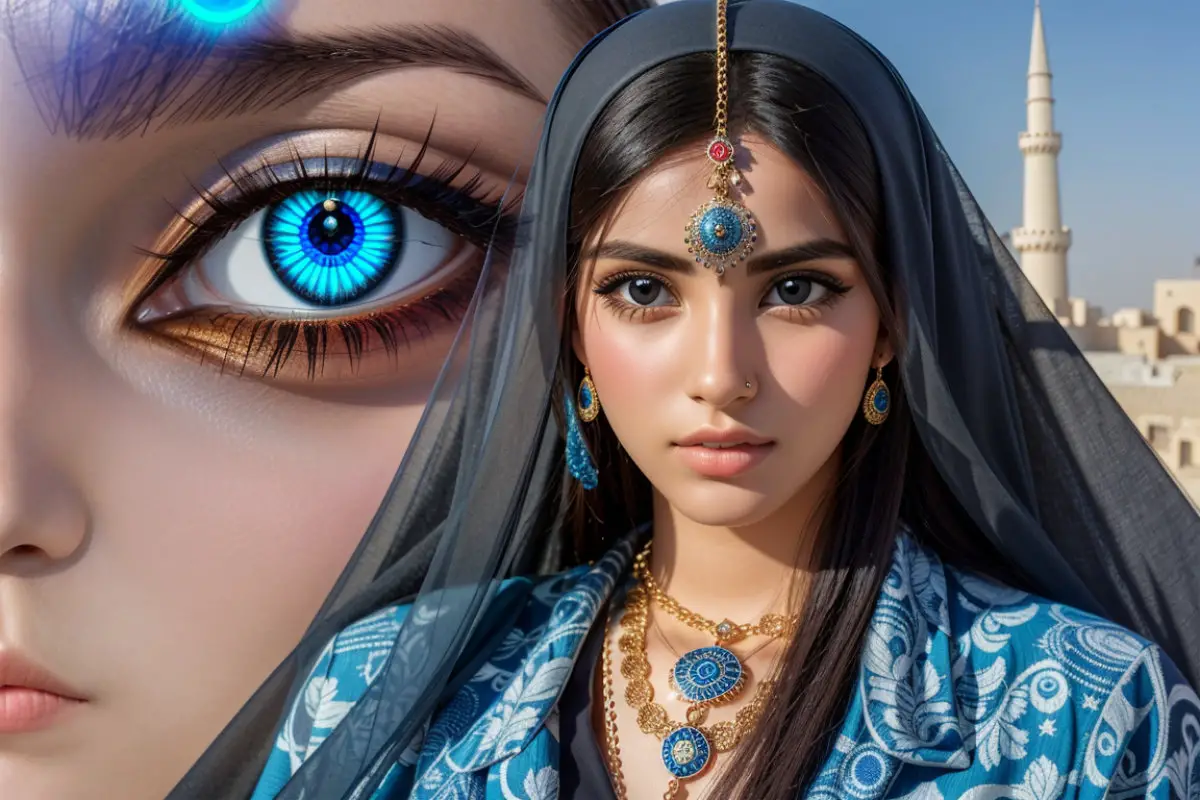Evil Eye History Middle East: Exploring the Ancient Beliefs in Middle Eastern Countries
Important Takeaways Of Evil Eye History Middle Eastern Countries
This ancient belief has persisted for centuries, shaping the customs and traditions of various countries in the region. Here are some key takeaways regarding the history of the evil eye:
1. Origins of the Evil Eye: The concept of the evil eye can be traced back to ancient civilizations such as Mesopotamia and Egypt.
These cultures believed that certain individuals possessed a powerful gaze that could cause harm or misfortune to others. The idea was rooted in a fear of envy and jealousy, as people thought that those who were successful or had good fortune would attract negative energy from others.
2. Widespread Belief: The belief in the evil eye is deeply ingrained in Middle Eastern culture.
It transcends religious boundaries and is shared among Muslims, Christians, Jews, and other faiths in the region. This widespread belief reflects its enduring influence on society, where it continues to shape daily life through various rituals and protective measures.
3. Symbolism and Talismans: To protect themselves from the malevolent effects of the evil eye, people in Middle Eastern countries have developed various symbols and talismans with protective properties.
The most common symbol used to ward off this negative energy is called an “evil eye amulet” or “Nazar,” which often takes the form of a blue bead with an eye-like design at its center. 4. Rituals and Practices:
Throughout history, people have relied on rituals and practices to counteract or prevent harm from the evil eye’s gaze. These can involve reciting prayers, performing specific gestures or motions with one’s hands (known as “khamsa” gestures), burning incense, or even wearing specific colors believed to repel negativity.
5. Cultural Significance: The belief in the evil eye has left an indelible mark on Middle Eastern culture.
It has influenced various aspects of daily life, from the way people dress to the design of their homes. For example, you can often find images and symbols associated with protection from the evil eye adorning houses, cars, and even jewelry.
Understanding these important takeaways about the history of the evil eye in the Middle East provides valuable insights into a belief that continues to shape cultural practices and traditions in the region. By recognizing its significance, we can appreciate its impact on daily life and gain a deeper understanding of Middle Eastern cultures and their rich heritage.

These countries in the Middle East have a history of believing in the evil eye
In the Middle East, belief in the evil eye runs deep and is pervasive across several countries. Let’s dive into the fascinating world of evil eye beliefs in this region. Starting with Israel, the evil eye, known as “Ayin Hara” in Hebrew, holds significant cultural significance.
Evil eye folklore is ingrained in Jewish traditions and can be traced back to ancient times. It is believed that a jealous or envious gaze can cause harm or misfortune to an individual.
To ward off this malevolent energy, many Israelis wear talismans like the “Hamsa,” a hand-shaped symbol with an eye at its center. Moving on to Lebanon, the evil eye is not only considered a superstition but also plays a crucial role in religious texts.
In Islamic tradition, it is exhorted to seek protection from the evil eye through prayers and supplications to Allah. Additionally, people often hang blue beads or Nazar amulets outside their homes or wear them as jewelry as a form of protection against its malevolent effects.
Iraq too has a long-standing belief in the power of the evil eye. Here, it is not uncommon for mothers to take various precautions to shield their newborns from this perceived threat.
Babies are adorned with amulets featuring either verses from the Quran or talismanic symbols known for their protective qualities. In Iran, they refer to it as “Blah”, which translates to envy or jealousy.
Evil eye superstitions are deeply rooted in Persian culture and influence daily routines and practices. Iranians often recite specific prayers while performing rituals such as burning incense or tying knots on pieces of cloth believed to absorb negative energy.
Turkey also shares a rich history regarding beliefs surrounding the evil eye—known locally as “Nazar Boncugu.” Evil eye protection takes center stage here with vibrant blue glass charms called Nazar beads adorning homes and workplaces alike. These charms serve as both decorative items and potent talismans to ward off evil spirits.
In Egypt, the evil eye holds sway both culturally and spiritually. Egyptians are known to wear amulets called “Khamsa,” meaning five in Arabic, which features an eye in the center surrounded by four fingers.
These amulets symbolize protection against malevolent energies and are believed to have ancient origins dating back to Pharaonic times. Across the Middle East, the evil eye is not merely a superstition; it is deeply intertwined with cultural practices, religious beliefs, and everyday life.
Its prevalence speaks volumes about its historical significance and enduring appeal. From legends and folklore to symbolic representations and protective rituals, the evil eye’s presence is undeniable in this region.
What Is the ‘Evil Eye? Isreal
What Is The History of the evil eye in Isreal?
In Israel, the belief in the evil eye has deep historical roots and is still prevalent today. Evil eye practices have been a part of the country’s culture for centuries, with references to its existence found in ancient civilizations like the Phoenicians and Canaanites.
The belief in the evil eye extends across various religious and ethnic groups, including Jews, Muslims, and Christians. Evil eye beliefs in Israel are intertwined with mythology and religious texts.
In Jewish folklore, it is believed that certain individuals possess the power to cast a harmful gaze upon others through their jealous or envious eyes. This notion can be traced back to biblical stories such as when Rachel envied her sister Leah’s fertility or when Joseph’s brothers were jealous of him.
To protect themselves from the evil eye, Israelis have developed various traditions and superstitions. One common practice involves wearing amulets or charms known as “hamsas” or “hand of Fatima,” which are believed to ward off negative energy.
These symbols are often seen adorning jewelry, clothing, or even displayed on walls and doorways. The cultural significance of the evil eye in Israel goes beyond mere superstition.
It has become an integral part of daily life and serves as a way for people to explain misfortunes or setbacks they may face. For instance, if someone falls ill or experiences a stroke of bad luck, it may be attributed to an envious gaze cast upon them.
The evil eye’s historical references can be found in ancient texts like the Talmud and Kabbalah as well. These texts delve into deeper explanations regarding how one can protect themselves against its effects using rituals such as reciting prayers or engaging in specific acts of faith.
Overall, understanding the history of the evil eye in Israel provides valuable insight into its cultural significance and how it has shaped beliefs and practices throughout generations. Whether seen as folklore or deeply rooted tradition, this phenomenon continues to capture the imagination and play a role in daily life for many Israelis.
📿 Tired of having too much negativity around?
Now you can boost your manifesting power and attract good things into your life easily with this Magnetic Tiger Eye and Hematite Bracelet!
FREE SHIPPING!
What Is The History of the evil eye in Lebanon?
Lebanon, a country steeped in rich history and vibrant cultural traditions, has its fair share of beliefs and superstitions surrounding the evil eye. The concept of the evil eye holds great significance in Lebanese folklore and is deeply ingrained in the daily lives of its people.
Dating back centuries, this ancient tradition continues to shape the Lebanese society. In Lebanon, the belief in the evil eye is widespread, and people take various measures to protect themselves from its malevolent effects.
One common practice is wearing amulets or talismans known as “nazar” or “ayn al-hasoud.” These charms are believed to ward off evil spirits and safeguard individuals from any harm caused by envy or malice. Similarly, blue beads or blue glass ornaments can be found adorning homes, cars, and even newborn babies’ cribs as a means of protection against the evil eye.
This belief also extends to religious texts in Lebanon. Many Lebanese households display verses from holy scriptures such as the Quran or Bible that are believed to have protective qualities against the evil eye.
Additionally, families may seek blessings from religious leaders or perform rituals involving prayer and incense burning as part of their efforts to counteract any potential negative influences. Lebanese folklore is replete with tales that further reinforce this belief in the evil eye.
Stories of misfortune befalling individuals who were thought to have attracted jealousy or ill-wishing are passed down through generations, adding a layer of cautionary wisdom to daily life. These legends serve as reminders for people to remain humble and avoid flaunting their successes too ostentatiously.
The symbolism surrounding the evil eye also finds expression in Lebanese culture. It can be seen in traditional art forms like mosaics, pottery, and jewelry where intricate patterns incorporating symbolic eyes are prevalent.
These motifs not only serve decorative purposes but also act as talismans against any potential harm caused by envy. Lebanon’s history is intertwined with the belief in the evil eye, which has shaped its cultural practices for centuries.
From wearing protective charms to displaying religious scriptures, the Lebanese people exhibit a deep-seated respect for this ancient tradition. The legends, superstitions, and symbolism associated with the evil eye continue to be an integral part of their daily lives, reflecting the enduring power of these beliefs in Lebanese society.
What Is The History of the evil eye in Iraq?
In Iraq, the belief in the evil eye runs deep within the cultural fabric of the country. It is seen as a powerful force that can bring harm and misfortune to individuals or even entire communities.
The history of the evil eye in Iraq can be traced back to ancient Mesopotamia, where it was believed that certain individuals possessed the ability to cast curses through their jealous or envious gaze. Evil eye legends and superstitions have been passed down from generation to generation, shaping the way people perceive and protect themselves from this malevolent energy.
People in Iraq have developed various practices to ward off the evil eye, such as wearing talismans or amulets featuring protective symbols like eyes or blue beads. These symbols are believed to deflect negative energy and keep one safe from harm.
The evil eye’s historical references can also be found in ancient texts and documents dating back centuries. While not explicitly mentioned, its influence is often felt indirectly through stories and folklore that warn against envy and jealousy.
It serves as a reminder of the destructive power these emotions hold when unchecked. Moreover, religious texts in Iraq, such as the Quran for Muslims or scriptures for other faiths present in the country, also touch upon concepts related to the evil eye.
They encourage believers to seek protection from negative energies by relying on faith and invoking divine intervention. The cultural significance of the evil eye in Iraq extends beyond individual beliefs; it permeates daily life and social interactions.
In many households, you will find Evil Eye safeguards placed near entrances or displayed prominently inside homes—a testament to people’s commitment to keeping their loved ones safe from harm. Understanding the history of the evil eye in Iraq reveals its deep-rooted presence within Iraqi culture.
It weaves together ancient traditions with contemporary beliefs and continues to shape how individuals guard against negative energies today. Whether through amulets, religious practices or folklore passed down through generations, people continue to navigate the unseen forces of the evil eye, hoping to preserve their well-being and prosperity.
What Is The History of the evil eye in Iran?
In Iran, the concept of the evil eye holds a deep-rooted place in its history and culture. The belief in the evil eye can be traced back to ancient traditions that have been passed down through generations. Iranians have held strong beliefs about the power of the evil eye, considering it to be a potent force capable of causing harm or misfortune.
Throughout Iranian history, various rituals and customs have been developed to protect against the evil eye. These practices range from wearing amulets or talismans with symbolic charms to reciting prayers or verses from religious texts.
Families often hang blue glass beads or Nazar boncuğu (also known as “evil eye beads”) in their homes, workplaces, and even on their cars as a means of warding off any potential negative energy. The mythology surrounding the evil eye in Iran is rich and diverse.
In ancient Persian folklore, it is believed that an envious gaze could bring about illness, bad luck, or even death. Legends often tell stories of individuals who possess an exceptionally powerful evil eye that can cast curses upon others with just a glance.
These tales serve as cautionary reminders to be mindful of one’s thoughts and intentions towards others. The cultural significance of the evil eye in Iran can be observed in various aspects of daily life.
For instance, during celebrations or special occasions such as weddings and childbirths, it is common for family members and friends to gift protective items like amulets or jewelry adorned with blue stones representing the power to repel negative energy. Additionally, references to the evil eye can also be found in religious texts such as the Quran and Hadiths (sayings of Prophet Muhammad).
Islamic teachings provide guidance on protecting oneself from envy and negative energies by seeking refuge in God’s blessings and reciting specific prayers for protection against malevolent intentions. Iran has a rich history when it comes to beliefs surrounding the evil eye.
From ancient traditions to contemporary practices, Iranians have embraced various methods to ward off the harmful effects of envy. The cultural significance of the evil eye in Iran is deeply ingrained in their folklore, customs, and religious beliefs, making it an integral part of their society.
What Is The History of the evil eye in Egypt?
In Egypt, the belief in the evil eye runs deep within the cultural fabric of this ancient land. Dating back thousands of years, the evil eye is woven into Egyptian folklore, practices, and superstitions.
It holds a significant place in both religious texts and ancient traditions. The concept of the evil eye in Egypt is often associated with envy and jealousy.
It is believed that certain individuals possess a powerful gaze that can bring harm or misfortune upon others. To protect against this malevolent power, Egyptians have developed various methods and rituals.
One common form of protection is wearing amulets known as “Eye of Horus” or “Wadjet Eye.” These amulets, usually made from materials like gold or lapis lazuli, are believed to ward off any negative energy cast by an envious glance. The Eye of Horus symbolizes royal power and divine protection.
Additionally, Egyptians have incorporated rituals into their daily lives to deflect the evil eye’s influence. For instance, mothers may adorn their infants with black kohl on their cheeks or foreheads as a means to divert attention from their beauty and thus safeguard them from any jealous stares.
Moreover, it is not uncommon to find charms or talismans featuring eyes displayed in homes or vehicles throughout Egypt. These symbols act as potent shields against any ill-intentioned glares that may cause harm or misfortune.
The history of the evil eye in Egypt intertwines with its rich mythology and legends. Ancient tales speak of gods and goddesses using their eyes’ divine power to protect against evil forces.
The symbolism associated with these stories further solidifies the belief in the evil eye’s potential impact on human lives. Egypt embraces the concept of the evil eye as an integral part of its cultural heritage.
With historical references dating back centuries and deeply rooted beliefs held by its people, it serves as a reminder for Egyptians to remain vigilant against envy and negativity. From ancient traditions to modern-day practices, the evil eye continues to hold great significance in Egyptian society.
What Is The History of the evil eye in Jordan?
In Jordan, the belief in the evil eye runs deep within the local culture. It has a rich history intertwined with ancient traditions and folklore. The concept of the evil eye is often associated with envy and jealousy, where it is believed that someone’s negative gaze can bring harm or misfortune upon others.
Evil eye mythology in Jordan is rooted in tales passed down through generations. Stories are woven around individuals who possessed the power to cast an evil eye and those who suffered its consequences.
These legends reinforce the notion that one must always be cautious of others’ intentions and protect themselves from potential harm. Historical references to the evil eye in Jordan can be found in various texts from different eras.
For instance, writings from early Islamic scholars mention its existence and warn against its dangers. The belief has continued to evolve over time, merging with local customs and traditions.
The cultural significance of the evil eye is evident in many aspects of Jordanian life. It influences how people dress or adorn themselves, with amulets or charms believed to ward off its effects.
Additionally, certain rituals are performed to cleanse oneself or a space from any perceived negative energies associated with the evil eye. Religious texts also play a role in shaping beliefs about the evil eye in Jordan.
Islamic teachings contain references that highlight the importance of seeking protection from envy and praising God to deter any potential harm caused by it. Superstitions regarding the evil eye are prevalent among Jordanians.
Many believe that certain behaviors or actions can attract unwanted attention and invoke jealousy, making them vulnerable to its effects. As a result, precautions are taken to avoid drawing unnecessary attention or boasting about one’s blessings openly.
Despite modernization and globalization, ancient traditions related to the evil eye continue to thrive in Jordanian society. These practices often include reciting prayers or using specific rituals passed down through generations as protective measures against its malevolent influence.
Symbolism surrounding the evil eye is also present in Jordan. Amulets or talismans, commonly in the form of an eye, are worn or displayed to ward off evil and offer protection.
This symbol serves as a constant reminder to remain vigilant against potential harm. The belief in the evil eye is deeply ingrained in Jordanian culture and manifests itself through various aspects of daily life.
It has a rich history rooted in mythology, historical references, and religious texts. The cultural significance and superstitions associated with it continue to shape people’s behaviors and practices, ensuring they protect themselves from its perceived negative effects.
What Is The History of the evil eye in Saudi Arabia?
In Saudi Arabia, the belief in the evil eye runs deep within the cultural fabric of the region. The concept of the evil eye, known as “al-‘ayn” in Arabic, has a long history rooted in ancient civilizations.
References to the evil eye can even be found in religious texts such as the Quran and Hadith. Evil eye practices in Saudi Arabia are diverse and varied.
People often recite protective prayers or wear talismans and amulets to ward off its malevolent effects. It is believed that those with a powerful gaze or an envious nature have the potential to cast harm upon others through their eyes.
Therefore, individuals take precautions to protect themselves and their loved ones from falling victim to such negative influences. The symbolism associated with the evil eye in Saudi Arabian culture is intriguing.
It is commonly depicted as a vibrant blue or green eye-shaped talisman, known as a “nazar,” which is believed to possess protective powers against its harmful effects. This symbol can be found adorning homes, cars, jewelry, and even clothing as a means of warding off any potential harm.
Ancient traditions and historical references provide insight into how deeply ingrained this belief is within Saudi Arabian society. Tales of supernatural encounters and mystical occurrences related to the evil eye are passed down through generations as part of their rich folklore and mythology.
Superstitions surrounding the evil eye are prevalent in daily life. For example, parents may refrain from praising their children too much for fear of attracting envy that could lead to misfortune or illness.
Likewise, people may avoid displaying wealth openly or discussing personal achievements openly out of concern for inviting ill intentions from others. The cultural significance attached to belief in the evil eye cannot be overstated in Saudi Arabia.
It serves not only as a way for individuals to protect themselves but also acts as a reminder of humility and gratitude amidst success and blessings. Understanding the history of the evil eye in Saudi Arabia reveals the profound influence it has on the culture and beliefs of its people.
From ancient traditions to modern superstitions, the concept of the evil eye shapes daily life and fosters a sense of caution and protection. It serves as a reminder to appreciate one’s blessings while remaining vigilant against negative energies that may seek to harm.
What Is The History of the evil eye in the United Arab Emirates?
In the United Arab Emirates, the belief in the evil eye is deeply ingrained in their culture and traditions. Evil eye practices have been prevalent in this region for centuries, with a rich history that intertwines with ancient civilizations and religious texts.
The symbolism of the evil eye holds great significance in Emirati culture. It is believed that certain individuals possess a powerful gaze that can unintentionally bring harm or misfortune to others.
Therefore, protecting oneself from the evil eye is of utmost importance to ensure good luck and well-being. To ward off the effects of the evil eye, Emiratis have developed various rituals and traditions over time.
These practices often involve using amulets, talismans, or charms known as “nazar” to protect against its malevolent influence. The nazar typically takes the form of an eye-shaped pendant or bead, traditionally made of blue glass or stone.
Cultural beliefs surrounding the evil eye are deeply rooted in Emirati society. It is not uncommon to find homes adorned with protective symbols like horseshoes or blue-colored eyes to deflect any ill-wishing directed towards them.
Furthermore, many individuals wear jewelry or carry small amulets with them as personal protection against the evil eye’s potential harm. The history of the evil eye in the United Arab Emirates reveals a blend of ancient traditions and contemporary practices.
While superstitions associated with it may have evolved over time, its significance remains strong within Emirati culture. From folklore to historical references and legends passed down through generations, understanding their beliefs surrounding this mystical phenomenon provides a fascinating glimpse into their cultural heritage and worldview.
What Is The History of the evil eye in Qatar?
In Qatar, the belief in the evil eye runs deep within the cultural fabric of the country. Evil eye beliefs have been passed down through generations, shaping traditions and influencing daily life.
This mystical concept, rooted in ancient superstitions and folklore, holds significant cultural significance for the people of Qatar. Historical references to the evil eye can be found in various Qatari tales and legends, showcasing its presence throughout centuries.
It is believed that certain individuals possess a powerful gaze capable of inflicting harm or misfortune on others. The evil eye is often associated with envy, as it is thought to be cast unknowingly by those who harbor jealousy or ill intentions towards another person’s success or possessions.
To protect themselves from the malevolent effects of the evil eye, Qatari people have developed various rituals and practices over time. One popular method involves wearing amulets or talismans featuring protective symbols such as an eye-shaped pendant known as a nazar.
These amulets are believed to ward off any negative energy directed towards an individual. Religious texts also play a significant role in shaping Qatari beliefs regarding the evil eye.
Islamic teachings emphasize seeking protection from Allah against any harm inflicted by envy or jealousy. Prayers and supplications are recited to invoke divine intervention and safeguard oneself from the potential effects of the evil eye.
Moreover, Qatar’s rich cultural heritage has further solidified its link with evil eye symbolism. Traditional art forms often incorporate motifs depicting eyes for their protective qualities.
These intricate patterns can be found adorning jewelry, textiles, pottery, and even architectural elements throughout Qatar. The practice of recognizing and protecting oneself from the evil eye continues to hold immense value in Qatari society today.
Whether through carrying personal amulets or conducting rituals steeped in tradition during important life events like weddings or childbirths, Qatari people remain steadfast in their efforts to ward off negative energy and ensure their well-being. The history of the evil eye in Qatar is deeply rooted in cultural beliefs, ancient traditions, and religious teachings.
The Qatari people’s strong belief in its existence is evident through their various protective practices, use of symbolism, and incorporation of the evil eye concept into their folklore. This enduring belief serves as a testament to the lasting cultural significance of the evil eye in Qatar.
What Is The History of the evil eye in Kuwait?
Kuwait, a fascinating country in the Arabian Peninsula, has its own unique history and cultural beliefs surrounding the evil eye. The belief in the evil eye runs deep within Kuwaiti society, where it is considered a significant aspect of their cultural heritage. Evil eye protection is highly valued and practiced by many Kuwaitis to ward off its negative effects.
According to ancient traditions and historical references, the evil eye has been acknowledged in Kuwait for centuries. It holds immense significance in the lives of locals, shaping their beliefs and influencing their daily practices.
Legends and folklore surrounding the evil eye have been passed down through generations, creating a rich tapestry of stories that explore its power. The influence of religion on the perception of the evil eye cannot be ignored either.
Kuwait being predominantly Muslim, Islamic teachings play a pivotal role in understanding and dealing with this phenomenon. References to the evil eye can be found in various religious texts, including hadiths (sayings of Prophet Muhammad), which offer guidance on protecting oneself from its malevolent gaze.
Evil eye practices are deeply ingrained in Kuwaiti society. Many individuals often wear protective talismans or amulets featuring symbols against the evil eye as a form of prevention.
These items hold great symbolic value and are believed to repel any harmful energy directed towards them. Moreover, ancient traditions associated with the evil eye continue to shape cultural norms in Kuwait.
Rituals such as cleansing ceremonies or wearing specific colors or charms during special occasions are commonly observed as a way to safeguard against its negative influence. Superstitions related to the evil eye are also prevalent among Kuwaitis.
They carefully avoid praising others excessively or displaying excessive wealth or success openly as they believe envy can attract ill will from others with an unintentional malicious gaze. Kuwait’s history with regards to the evil eye showcases how deeply ingrained this belief is within their culture.
From ancient traditions and religious references to folklore and superstitions, the evil eye holds significant cultural and spiritual value for Kuwaitis. It serves as a reminder of the power of perception and the importance of protecting oneself from negative energies that can be directed by others.
Conclusion
As we conclude our exploration into the fascinating history of the evil eye in the Middle East, it becomes evident that this belief has deep roots and a significant impact on the region’s culture and traditions. Throughout centuries, people in countries such as Egypt, Lebanon, Jordan, Syria, Iraq, and Iran have held steadfast to their conviction in the power of the evil eye. One important takeaway from this journey is that the belief in the evil eye is not simply a superstition or a myth; rather, it is deeply ingrained in these societies’ belief systems.
From ancient times to modern-day practices, individuals have sought protection against its malevolent influence. They employ various methods to ward off and ward away any ill-intentioned gaze that may bring harm upon them or their loved ones.
Another key aspect to note is how prevalent this belief remains across different social classes and educational backgrounds. The evil eye does not discriminate; it can affect anyone regardless of their wealth or status.
As a result, people have developed numerous rituals and talismans over time to counteract its effects. From wearing amulets adorned with blue eyes as protective charms to reciting prayers and performing religious rituals for protection against its powers – these customs are deeply embedded within their everyday lives.
Furthermore, understanding the historical context surrounding this belief sheds light on how it has evolved over time while remaining an integral part of Middle Eastern cultures. The interconnectedness between regions allowed for cross-cultural exchanges of beliefs and practices related to the evil eye.
This phenomenon can be seen through similarities found within different countries’ traditions – despite variations in specific rituals or symbols used. Delving into the history of the evil eye in the Middle East uncovers a rich tapestry woven with ancient beliefs and customs passed down through generations.
It serves as a testament to humanity’s enduring fascination with unseen forces that shape our lives. Whether one views it as pure superstition or holds firm faith in its powers, the evil eye continues to leave an indelible mark on the cultures of the Middle East, reminding us of the intricate interplay between beliefs and our collective human experience.
Frequently Asked Questions
1. What is the evil eye and why is it believed in? The evil eye is a belief that certain individuals possess the power to cast a malevolent gaze upon others, causing harm or misfortune.
The belief in the evil eye has been deeply ingrained in Middle Eastern cultures for centuries, stemming from ancient superstitions and folklore. It is believed that jealousy or envy can trigger the evil eye, leading to various forms of bad luck or ill effects on the person being targeted.
To protect themselves from this perceived threat, people in the Middle East have developed numerous rituals, amulets, and talismans believed to ward off the evil eye. 2. Are there any specific signs or symptoms associated with being affected by the evil eye?
According to popular beliefs surrounding the evil eye in the Middle East, there are several signs that indicate someone has fallen victim to its power. These signs can include sudden illness, unexplained headaches or stomachaches, chronic fatigue, a string of unfortunate events occurring simultaneously, inexplicable mood swings or changes in behavior, and even financial difficulties.
It is important to note that these symptoms may also be attributed to other causes; however, those who strongly believe in the power of the evil eye often attribute them directly to its influence. 3. How can one protect themselves against the evil eye?
Protecting oneself against the malevolent effects of the evil eye is taken seriously by many people in Middle Eastern countries. Various traditional methods are believed to provide protection against this supernatural force.
One common practice involves wearing talismans or amulets designed specifically for this purpose – most notably nazar boncuk (evil-eye beads) – which are believed to act as shields against harmful gazes. Additionally, certain actions like spitting three times over one’s left shoulder or reciting protective prayers are thought to counteract any negative energy directed towards an individual.
4. Is belief in the evil eye limited to the Middle East? While belief in the evil eye is most prevalent in Middle Eastern cultures, it is not exclusive to this region.
Similar superstitions and practices can be found in various other parts of the world, including Mediterranean countries like Greece, Italy, and Turkey. In fact, belief in the evil eye has transcended borders and gained recognition globally due to its enduring presence in popular culture.
It has become a symbol often associated with protection against envy and misfortune. The history of the evil eye in the Middle East is deeply rooted in ancient beliefs and folklore.
The concept of this malevolent gaze continues to influence cultural practices today, with many individuals taking measures to protect themselves against its perceived harmful effects. Whether one believes in its power or not, understanding the history and significance of the evil eye provides valuable insight into Middle Eastern cultures and their intricate belief systems.
Sources
- Evil Eye Hand: Unveiling the Mystical Origins and Meanings - February 2, 2024
- Amegreen Amethyst Meaning: Discover the Hidden Magic! - February 2, 2024
- Is The Evil Eye Bad?: A Deep Dive into Evil Eye Taboos - February 2, 2024








